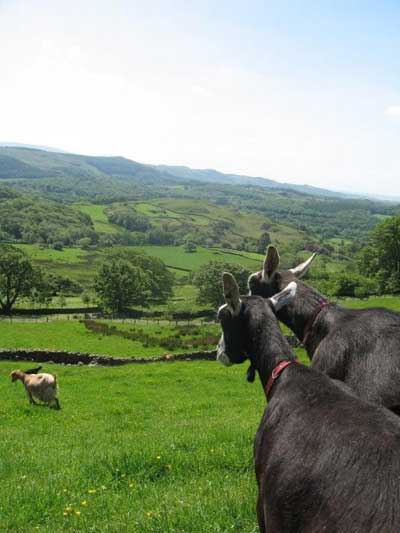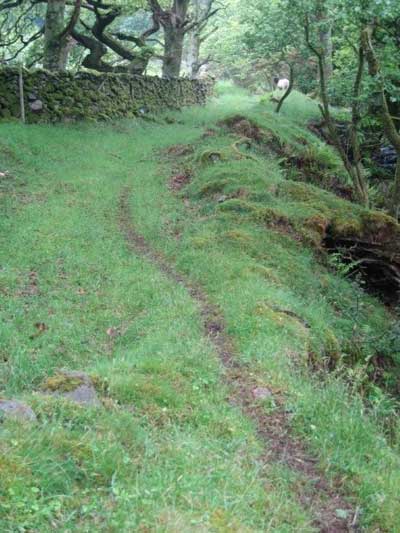Not so silly billies
By Ruth D’Alessandro, The Wildlife Gardener The Wildlife Gardener has always rather liked goats. They are calm, friendly, hardy, with a bit of an attitude. Some are bred to produce tasty milk which means even tastier cheese; others produce hairy wool to make itchy jumpers. All goats produce cashmere: you just have to comb them. They are intelligent (able to undo zips and shoelaces), playful (happy to skip around chasing human kids) and affectionate (will sit on your lap given the chance).

So when la famille Wildlife Gardener had a chance to stay in a holiday cottage on a Cumbrian hill farm with 250 Herdwick sheep and a herd of 14 dairy goats owned by two old university friends, Adrian and Margie, we packed up the WGmobile and headed for the hills. Yew Tree Farm is an astonishingly beautiful place in the unspoilt area of Wasdale. Out of one kitchen window you can see Scafell Pike, England’s tallest mountain, and Wast Water, the deepest lake in Cumbria, and out of the other you can see the sea. There are stone walls, gushing becks, bluebell woods, bats, buzzards, red kites, cuckoos, woodpeckers, owls, even a golden eagle. The bird table resembles the centre spread of a child’s Big Sticker Book of British Birds. It is so untouristy that when I wandered into the fish and chip shop in nearby Seascale and asked the owner if he had any fish ready, he replied, “Er, I’m actually closed. It is a Bank Holiday, you know.†But back to the goats. Adrian and Margie’s pedigree Woolsome Goats herd are mainly Toggenbergs and Alpines (Heidi goats), with a few Golden Guernseys thrown in for contrasting orangeness:

Goats bred at Yew Tree Farm are named after elements in the Periodic Table, which gives each one a name and an automatic tag number. So the 12th goat is called Magnesium, tag number 12. I am looking forward to goat no. 44, Ruthenium, but feel sorry for goat no. 5, Boron. Adrian writes:
At one time we were going to select the males and females names so that offspring could be IUPAC named to describe the pedigree but that was going to be too hard – especially as we decided to sell Carbon!. I always wanted a goat called 4,4-Dimethyl-1,3-cyclopentane dicarboxylicate (even if the BGS couldn’t register the name)
I guess after Ununoctium (118) Adrian and Margie will be ready to retire. But not before amassing an extraordinary wealth of goaty anorak facts. This is perhaps the most entertaining:
Givenchy it is not. The smell permeates everything, including the valley. Even the Tesco delivery driver has to shut her window when driving past. Traditionally, to test if a nanny goat was receptive for mating, the billy’s stinky beard would be wiped down with a rag and the rag placed in a screw-top jar. The lid would be taken off in the nannies’ barn and whichever nanny wagged her tail at the scent would be taken off to make friends with the billy. A myth that has grown up around goats is that they will eat anything. Wrong. They are actually very fussy animals. The lead male in a wild herd will nibble a new foodstuff first. If it is tasty, the lead female will nibble it, pronounce it edible, and only then will the rest of the herd eat it. If the king and queen won’t eat it, the rest of the herd won’t either. So it is a big responsibility of the lead animals to find safe food and teach the others what they can eat. Like cows, goats have no upper top teeth, just a leathery dental pad to nibble against. It’s fine to let goats nibble your fingers: just don’t put the pinkies anywhere near their razor-sharp back molars (as I did – ouch) as these are adapted for slicing through tree branches better than secateurs. And goats are ruminant animals, so they wolf down vegetation as fast as they can to avoid predators, then regurgitate it later to’chew the cud’ when the coast is clear. I had the dubious pleasure of smelling a goat’s breath while it was cud-chewing. Oddly, it smelt of camphor. Adrian and Margie also have a herd of feral Bagot goats, a very ancient rare breed. They keep them for no other reason than’they’re nice’. And what more reason do you need to keep animals if you have the space? These goats exist semi-wild, wandering round the 90 acres at will. Goats are creatures of routine and you can see this even in the ferals: they don’t wander randomly, but follow well-trodden, self-made goat paths round the farm:

Whether this is to ensure for the herd safe terrain or to follow tasty browsing is anybody’s guess, and is surprising considering the goat’s reputation for sure-footedness and brinkmanship on high mountain ledges. We were all so taken by the Woolsome Goats that we go all misty-eyed when talking about them. We’re excited by the imminent arrival of Chlorine (17), Junior Wildlife Gardener no. 1 learned to milk a goat with both hands in a week, and we all learned how to feed and tend some of them when the other Woolsomes went off to a goat show for a couple of days. Junior Wildlife Gardener no. 2 and I played with the goats in the field so much that we picked up sheep ticks, but no matter, that’s material for a later article. If I had to say why I like goats so much, I think Adrian’s right: they are nice. And if, like the Wildlife Gardeners you fancy a Woolsome Goat experience, Bank Barn on Yew Tree Farm is available for holiday lets.
- Spurn Spawn! - 26th February, 2014
- Bluebells on wheels: axles of evil? - 2nd February, 2011
- Raising the ba: Wildlife and the Ancient Egyptian Book of the Dead - 8th January, 2011

Thanks Connie! Goats and chickens are big faves – I envy you keeping goats! I already have some chickens.
Thank you for mentioning the camphor smell…that is what I was googling…and I found such lovely comments about goaties…I have some…and never knew I liked goats, although one of my favorite childhood stories was Heidi!
Well, I am off to tend the goats…and chickens. Lovely pics, too. Ta!